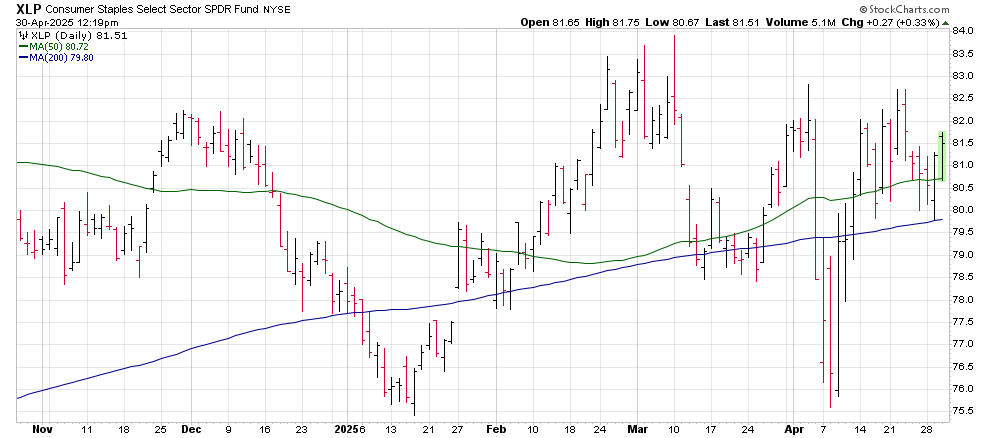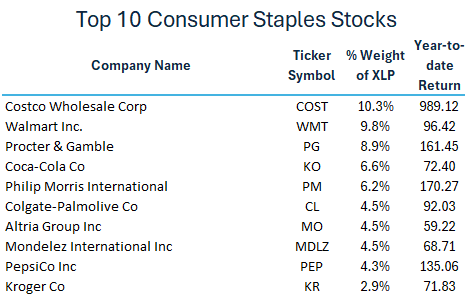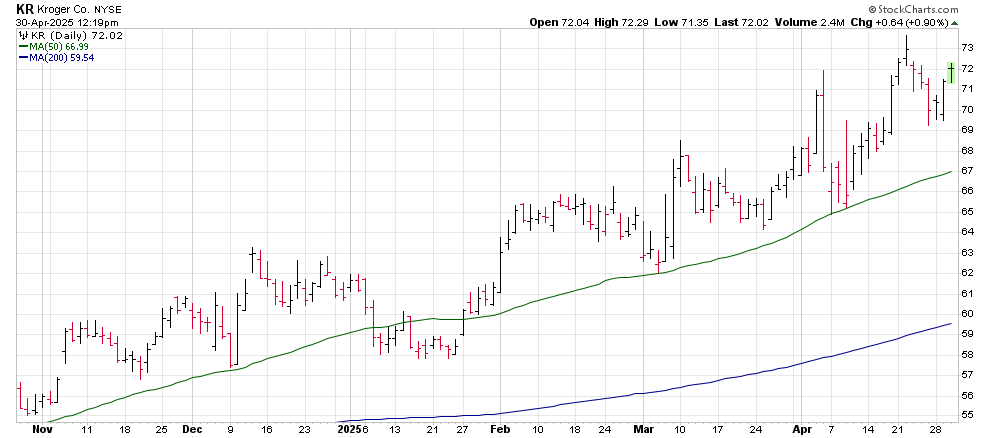Investors searching for stability in the face of rising uncertainty are finding refuge in a familiar place—consumer staples.
With recession fears resurfacing and inflation still a concern, the sector has become a safe harbor in the storm, offering consistency, income, and resilience when the broader market struggles to find direction.
The latest economic data underscores the severity of the current backdrop.
According to an initial report released by the Commerce Department, U.S. gross domestic product (GDP) declined by 0.3% in the first quarter of 2025. This marks the first economic contraction since 2022 and stands as a red flag for investors already jittery about weakening fundamentals.
While the economy remains far from collapse, cracks are beginning to show. Consumer spending, which powers roughly two-thirds of U.S. economic activity, climbed just 1.8%—its slowest pace since mid-2023.
Even more concerning is the nature of the slowdown.
Imports surged dramatically, indicating that foreign demand is displacing domestic goods, while inflation remained uncomfortably sticky. And although Washington is still working to hammer out new tariff deals, the mere prospect of higher trade barriers is compounding investor fears about stagflation—a toxic mix of slowing growth and persistent price pressures.
Why Consumer Staples Now?
In most market downturns, institutional money seeks safety in U.S. Treasurys and other fixed-income assets. But this time, things are different.
With the U.S. dollar down more than 6% since the start of the year and federal deficits ballooning, confidence in the bond market has weakened. Instead, investors are pouring into equity sectors with low volatility and consistent returns—most notably, consumer staples.
 Consumer staples companies sell goods and services that remain in demand regardless of the economic cycle.
Consumer staples companies sell goods and services that remain in demand regardless of the economic cycle.
Think of food, beverages, personal care items, tobacco, and household necessities. Unlike discretionary purchases, which consumers cut back on during lean times, these products are bought no matter what—making staples companies uniquely resilient during downturns.
Consumers may skip a vacation or delay large purchases, but they’re not skipping toothpaste, soda, or detergent. That makes consumer staples one of the last dominoes to fall in a recession.
A One-Stop Shop for Staples Exposure
For investors looking for diversified exposure to the sector, the Consumer Staples Select Sector SPDR ETF (XLP) is a convenient choice. The ETF holds a basket of blue-chip consumer staples companies and is designed to mirror the performance of the sector within the S&P 500.
 These companies are not only household names—they’re also dividend machines. With above-average yields and durable business models, many of these stocks serve dual roles: as growth-protectors during downturns and income-generators when interest rates plateau.
These companies are not only household names—they’re also dividend machines. With above-average yields and durable business models, many of these stocks serve dual roles: as growth-protectors during downturns and income-generators when interest rates plateau.
The Consumer Staples Select Sector SPDR ETF pays an attractive 2.58% dividend yield as a result.
Top Performers in 2025
So far in 2025, several consumer staples names have delivered standout returns. According to year-to-date data through April 29:
 Philip Morris International (PM) leads the pack, up 41%, driven by strong international demand and pricing power in smokeless tobacco products.
Philip Morris International (PM) leads the pack, up 41%, driven by strong international demand and pricing power in smokeless tobacco products.- Dollar General (DG) has rebounded 23% as investors seek deep-discount retail exposure.
- Kroger (KR) shares have each posted 17% gains, benefiting from defensive demand and inflation-fighting reputations. Kroger has also expanded aggressively into the delivery service opting for less expensive warehouse and vehicles to retail shopping spaces. The move has increased margins.
- Beverage giants Coca-Cola (KO) and Monster Beverage (MNST) are up 16% and 13% respectively, showing that consumer loyalty and demand for “comforts” remains strong even in tighter economic conditions.
Other notable names include Altria Group (MO) (+12%), Mondelez (MDLZ) (+10%), Kenvue (KVUE) (+10%), and Costco (COST) (+8%).
Spotlight: Kroger and Costco
Among retailers, Kroger (KR) is drawing special attention. Shares are currently trading above both the 50-day and 200-day moving averages, signaling bullish technical momentum. Despite the strong performance, most Wall Street analysts still rate the stock as a “hold,” meaning that price target revisions and potential upgrades could provide further upside.
Costco (COST), meanwhile, remains a perennial favorite thanks to its membership model and reputation as an “inflation-fighter.” Bulk goods and pricing advantages give it unique pricing power that appeals to consumers during inflationary periods.
 The Bottom Line
The Bottom Line
While no investment is immune to macroeconomic headwinds, consumer staples offer a level of predictability that few other sectors can match.
The sector’s strength in 2025 highlights just how valuable stability and consistency have become in a market increasingly dominated by volatility, geopolitical uncertainty, and fears of stagflation.
For investors seeking to protect capital while maintaining exposure to equity markets, consumer staples provide a compelling solution. Whether through individual stocks like Kroger, Coca-Cola, or Philip Morris—or through a diversified vehicle like XLP—the sector is once again proving that boring can be beautiful when times get tough.
— Chris Johnson
NEW THIS WEEK: Huge Energy Discovery In Utah [sponsor]The Department of Energy say it could power America for millions of years. And both grizzled oilmen and clean energy supporters love it: Energy Secretary Chris Wright called it "an awesome resource," while Warren Buffett, Jeff Bezos, Mark Zuckerberg, and Bill Gates are all directly invested. Here's the name of the company at the heart of it all.
Source: Money Morning
